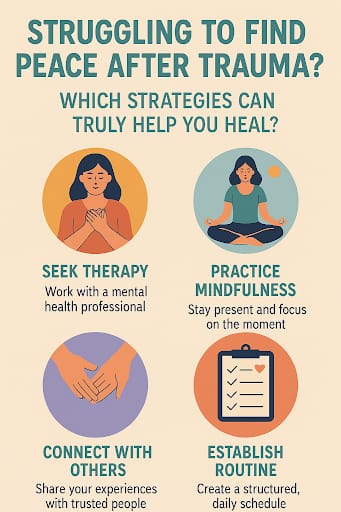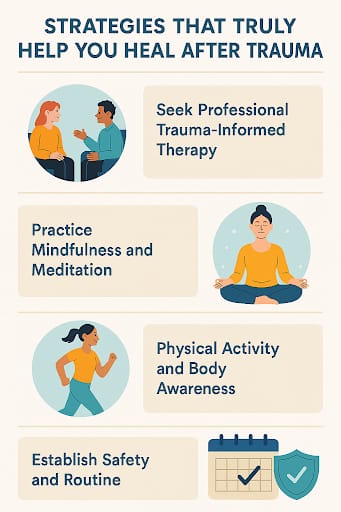
INTRODUCTION
Finding peace after trauma can be difficult and lonely, but recovery is possible. Trauma disrupts the very essence of our emotional and mental well-being, and we are often left searching for a way to return to a sense of calm and normalcy.
The journey you take to achieve this is personal, but there are evidence-based approaches that are available to support you in recovering — allowing you to embrace pain, reestablish resilience and obtain hope.
In this blog, we will highlight common and effective healing strategies (e.g., therapy, mindfulness, self-care/self-compassion, and utilizing a support system) so you can choose actions you can take to heal and find peace in your life again.
What Is Trauma?
Trauma is the emotional response to distressing events, such as accidents, crimes, natural disasters, physical or emotional abuse, neglect, seeing violence, death of a loved one, war, etc.
- After trauma, individuals will often feel shock and denial; however, as time moves forward, and the trauma effects have passed, individuals may experience more persistent frustration, uncontrolled and intense emotional experiences, sequential flashbacks of the event, difficulty in relationships, and even physical symptoms such as headache or nausea.
- While sometimes these emotional and physical challenges can persist, it can also be viewed as healing.
- Unfortunately, some individuals will continue to struggle with the trauma.
- Psychological support can provide healthier and more constructive ways to manage what individuals are feeling through valuable tools and strategies.
How Trauma Disrupts Peace?
Trauma severely disrupts your internal sense of peace by shattering a feeling of safety internally.
- After experiencing trauma, the brain can become stuck in survival mode, remaining in hyper-arousal and scanning the environment for danger, even when there is no threat.
- This hyper-vigilance, in conjunction with intrusive memories, emotional numbing or avoidance, creates a state of unrest.
- Trauma can have emotional effects such as anxiety, depression, guilt, shame, irritability, and helplessness.
- Trauma can also come through physically like fatigue, chronic pain, digestive issues, or an increased heart rate.
- Cognitively, trauma may lead to difficulty concentrating, forgetfulness, or distorted beliefs about oneself.
- In relationships, it may create distrust, social isolation, or difficulty being intimate.
- Left unhealed, trauma can persist for months, years, or even decades, ultimately getting in the way of living life fully and peacefully.
Strategies that Truly Help You Heal After Trauma

1. Seek Professional Trauma Informed Therapy
It is often essential for an individual seeking to heal from their trauma to find a professional trauma-informed therapist. Trauma-informed therapists know how it’s affected other people and why people act impacted by trauma and utilize effective strategies to help fellow humans heal from their pain.
- Cognitive Behavioral Therapy (CBT) presents positive strategies and tools to identify and change harmful thinking patterns that have been created because of trauma.
- Eye Movement Desensitization and Reprocessing (EMDR) uses guided eye movement to reprocess impactful memories, reducing the emotional distress.
- Somatic Experiencing helps release trauma stored in the body using mindful movement and awareness.
- Trauma-Focused Cognitive Behavioral Therapy (TF-CBT) is the best-intervention, especially for young children and teenagers, but is also still effective for adults.
Narrative Therapy assists someone in recovering their power by rewriting their trauma story to create resilience and understanding of oneself.
2. Practice Mindfulness and Meditation
Mindfulness practices promote awareness of your thoughts and feelings without judgment, helping you stay in the present versus getting stuck in past trauma or worrying about the future. This is another key factor in trauma healing as mindfulness reduces anxiety, depression, improves emotional regulation, and calms a stressed out hyperactive response.
- Mindfulness creates awareness of yourself and self-compassion, which are both important in one’s journey to healing.
- There are a multitude of ways to incorporate mindfulness into your daily routine. You can try simple techniques of mindfulness, such as deep breathing practices, guided meditations, or body scans.
- Mindfulness apps like Headspace, Calm, or Insight Timer can also help establish these practices.
3. Physical Activity and Body Awareness
Trauma can lead the body to hold tension and dysregulated nervous system responses, so moving your body can be very healing. When you move your body in a way that feels safe, you can regain a sense of belonging in your body, but also release the tension and stress stored in your body.
- Trauma sensitive yoga in particular presents a way to slowly and gently reconnect with bodily sensations and breath in a way that reconstructs safety and awareness back to the body.
- Walking or hiking in nature utilizes movement, but also employs the benefits of being in nature to promote calm—being in nature becomes a grounding practice.
- Practices like Tai Chi or Qigong utilize slow, intentional movements while at the same time, re-establishing balance and calming the nervous system.
- Cardiovascular exercise releases endorphins and decreases stress hormones, fostering emotional wellness.
- Moving your body and listening to what it has to say by engaging in movement, you are provided a powerful ally in trauma recovery, allowing it to guide you in a nurturing and healing way.
4. Establish Safety and Routine
After going through a traumatic experience, it is critical to develop a sense of safety to allow healing and recovery.
- Developing predictable routines helps to create stability, while creating a soothing, calming environment at home provides opportunities for comfort and peace.
- Grounding techniques, like feeling your feet on the floor, or holding a comforting item, help to anchor you in the present moment.
- Setting barriers gives you emotional and physical protection, providing further confirmation of security.
- Collectively, these steps calm the nervous system and provide a solid grounding to begin deeper healing, moving towards reinstating control and resilience into your life again.
Additional Tips for Navigating the Healing Journey
Trust the process of growth and healing takes time and cannot be rushed.
- There are many unhealthy coping ways to manage pain and trauma, such as alcohol or drugs and other distractions that should be avoided.
- Taking the time to learn about trauma and the healing journey will help not only your understanding of trauma and healing but will also give you a sense of power and control in this experience.
- Remember you can always ask for help and search for support when needed. You will see that healing is often best shared with connections.
- Finally, take the time to remember to celebrate your survival and resilience. Recognize the level of strength it takes to survive trauma and understand how far you have come in the process.
Final Thought
Recovering from trauma is a deeply personal and transformational journey. The process of healing can take time and can be challenging, but it can hold so much promise for personal growth, resilience, and peace.
- Accepting support from a therapist, practicing mindfulness, taking care of your body, and creating safety can be very powerful means of reclaiming your life.
- Remember that healing doesn’t come overnight, so be kind to yourself. Seek connection, give yourself space to experience everything you’re feeling, and trust that it is possible to have peace in your life again.
- Engaging actively in your process of recovery is honoring your strength and heading toward a life filled with hope, balance, and a new purpose.
Reference
- “Trauma.” American Psychological Association, https://www.apa.org/topics/trauma
- Treatment, C. F. S. A. (2014b). Understanding the impact of trauma. Trauma-Informed Care in Behavioral Health Services – NCBI Bookshelf. https://www.ncbi.nlm.nih.gov/books/NBK207191/
- Yadav, G., McNamara, S., & Gunturu, S. (2024, August 16). Trauma-Informed therapy. StatPearls – NCBI Bookshelf. https://www.ncbi.nlm.nih.gov/books/NBK604200/
- Kachadourian, L. K., Harpaz-Rotem, I., Tsai, J., Southwick, S., & Pietrzak, R. H. (2021). Mindfulness as a Mediator between Trauma Exposure and Mental Health Outcomes: Results from the National Health and Resilience in Veterans Study. Psychological Trauma : Theory, Research, Practice and Policy, 13(2), 223. https://doi.org/10.1037/tra0000995
- Oosterbroek, T., & Dirk, B. (2021). The experience of Trauma Center-Trauma Sensitive Yoga training on professional practice of mental health professionals and yoga instructors. Complementary Therapies in Clinical Practice, 43, 101365. https://doi.org/10.1016/j.ctcp.2021.101365
- Niles, B. L., Reid, K. F., Whitworth, J. W., Alligood, E., Williston, S. K., Grossman, D. H., McQuade, M. M., & Mori, D. L. (2022). Tai Chi and Qigong for trauma exposed populations: A systematic review. Mental Health and Physical Activity, 22, 10.1016/j.mhpa.2022.100449. https://doi.org/10.1016/j.mhpa.2022.100449






